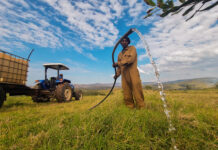Digital services radically enhance managing water infrastructure, and municipalities use them to increase revenues and improve service delivery.
Over a century ago, steam was the engine behind the Industrial Revolution, powering mining pumps, trains carrying goods and people, and factory machines. Back then, a massive drive shaft would run through a factory building, providing its spinning energy to smaller machines through an array of belts and drawing that energy from a large on-site steam engine.
Then electricity arrived and changed everything. Factories could do away with the space-occupying shaft and steam engine, using wires to connect equipment to electric power. Soon, a new breed of factory rose, designed to get the most from electricity. It made factories faster, cheaper and more effective.
Today, the digital revolution is changing infrastructure sites again, but more subtly. Electronic devices, broadband networks, software and sensors improve access to a site’s operations, information, and opportunities. However, unlike the steam-to-electricity transitions, the digital era doesn’t require tearing down buildings or other established infrastructure. Digital tools can augment and enhance what’s already available, a significant opportunity for the water sector.
“Digital services are helping water systems become more efficient and profitable,” says Chetan Mistry, Strategy and Marketing Manager at Xylem Africa. “Data analytics, edge computing, IoT sensors, and artificial intelligence enhance current source to tap water operations with real-time visibility, planning simulation, and preventative and predictive maintenance. These improvements extend the lifespan and value of water sites, reduce costs and also grow revenue.”
Helping Municipalities do and gain more
Municipal water systems worldwide are under rising pressure to meet the demands of growing urban populations and industry. At the same time, they are losing extensive amounts of money through infrastructure breakdowns and water losses.
Non-revenue water is exceedingly high in South Africa, affecting nearly half of all piped water and creating billions of rands in losses. Reversing these losses pays lucratively. When the Midvaal local municipality decided to tackle its 32.4% non-revenue water losses, it created the opportunity to earn back over R54 million in savings across five years by reducing water losses to 20%.
Doing so is within reach through water digitisation and a clear strategy. The municipality’s strategy involves several crucial actions, including creating a master water plan, calculating and preparing monthly water balances for different regions under its control, improving asset management, and detecting and closing leaks.
These tasks would have been challenging and even impractical in the past. Using digital technologies, they streamlined challenging tasks by analysing historical and current usage data, deploying leak detection systems, and using pre-emptive maintenance planning. The results are returning millions to municipal coffers. SA’s struggling towns and cities, burdened with over R100 billion in debt, can benefit considerably from water digitisation.
Digital water is a nuanced journey
Electricity supplanted steam. But digital doesn’t replace previous generations of equipment. Instead, it enhances through modular designs and flexible software, nuanced additions that require several stages of planning, deployment and testing. A strategic and partner-supported approach to water digitisation delivers quick results in some areas. And after that, more extensive benefits come from long-term digitisation.
Vertical experience also matters: companies specialising in specific sectors, such as water, have much better data and scope for analysis than generalist digital providers.
“Digital water systems can integrate with existing systems and data, delivering some gains quickly and with minimal disruption to the site,” says Mistry. “But sites must evolve if they want to get long-term benefits from digital management. The best strategy is to take it in steps and with planning that ensures continuity for the site.”
Fortunately, there is a wealth of experience available to manage digitisation projects, both as a general practice in various sectors and specialised insight into digitising water operations, “Water technology companies invest consistently in developing and deploying digital systems, in technical aspects but also areas such as security, compliance, data migration, and cloud systems. Some solutions are very turnkey and quick to start using. Others take more time, but can avoid the missteps of previous deployments.”
Digitisation is not a small project, but can be delivered in manageable steps. The outcomes are more revenue, improved control and planning, and extending the life of valuable water infrastructure. How much opportunity are your water systems leaving on the table? Digital water services put that opportunity back in your hands.








